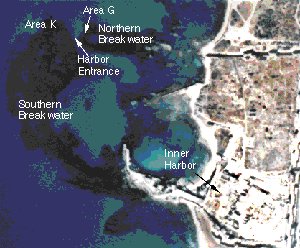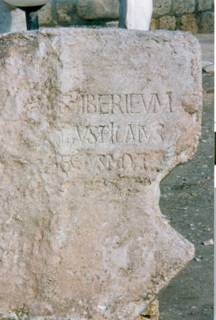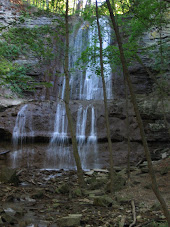
Aerial View of Caesarea
I went to Caesarea on Saturday night! Well, not quite but almost. Even better still, the trip was free It was hosted by the venerable Hamilton Association for the Advancement of Science, Literature and the Arts. The tour guide was marine archeologist, and McMaster University Professor, Dr. Eduard Reinhardt.
Dr. Reinhardt presented an illustrated summary of the underwater archeological research at Caesarea in Israel in which he has shared since 1990. Researchers have been trying to reconstruct the history of the artificial harbour built by King Herod between 20 and 10 BC in the Roman city of Caesarea (about halfway between Haifa and Tel Aviv in modern Israel). This construction project was astounding in both its scope and in its utilization of new technology. The construction of a sizeable harbour on a stretch of exposed coastline required the most up to date engineering skills of that era including the use of hydrolic cement that hardens underwater. (And here I thought that cement was a new building material!) Ash from Mount Vesuvious in Italy was the "secret ingredient" that allowed the cement to set underwater. Regrettably the harbour at Caesarea, despite all its elegance only survived for a little over a century. Recent archeological work has been trying to determine whether the port was destroyed by an earthquake or a tsunami (a giant sea wave).
As I listened to Dr. Reinhardt's presentation I found myself thinking about how prominently the city of Caesarea figures in the events recorded in "The Acts of the Apostles" in the New Testament. It was thrilling to think that on at least two occasions the Apostle Paul had sailed from that very harbour.
Paul's first visit to Jerusalem after his conversion to Christianity was cut short when conspirators tried to kill him. His new Christian friends took him from Jerusalem to Caesarea where they secured passage for him on a ship sailing north up the coast to Paul's native city of Tarsus (Acts 9:30). Paul began another life transforming sea voyage from Caesarea near the end of his life when he set out from Caesarea, guarded by a centurian of the Roman Imperial Regiment, who was escorting Paul to Rome to present his legal appeal to Caesar.
King Herod built not only a harbour at Caesarea but an impressive city that included a palatial residence for the Imperial Roman Governor, an adminstrative headquarters including prison cells (in which Paul was a guest of the state for two years), a hippodrome for chariot races, and an amazing open air amphitheatre. As the Roman Governor of Judea, Pontius Pilate was in Jerusalem for the Jewish passover celebration and available to pass judgement on Jesus, but his regular place of residence was in Caesarea.
Dr. Reinhardt presented an illustrated summary of the underwater archeological research at Caesarea in Israel in which he has shared since 1990. Researchers have been trying to reconstruct the history of the artificial harbour built by King Herod between 20 and 10 BC in the Roman city of Caesarea (about halfway between Haifa and Tel Aviv in modern Israel). This construction project was astounding in both its scope and in its utilization of new technology. The construction of a sizeable harbour on a stretch of exposed coastline required the most up to date engineering skills of that era including the use of hydrolic cement that hardens underwater. (And here I thought that cement was a new building material!) Ash from Mount Vesuvious in Italy was the "secret ingredient" that allowed the cement to set underwater. Regrettably the harbour at Caesarea, despite all its elegance only survived for a little over a century. Recent archeological work has been trying to determine whether the port was destroyed by an earthquake or a tsunami (a giant sea wave).
As I listened to Dr. Reinhardt's presentation I found myself thinking about how prominently the city of Caesarea figures in the events recorded in "The Acts of the Apostles" in the New Testament. It was thrilling to think that on at least two occasions the Apostle Paul had sailed from that very harbour.
Paul's first visit to Jerusalem after his conversion to Christianity was cut short when conspirators tried to kill him. His new Christian friends took him from Jerusalem to Caesarea where they secured passage for him on a ship sailing north up the coast to Paul's native city of Tarsus (Acts 9:30). Paul began another life transforming sea voyage from Caesarea near the end of his life when he set out from Caesarea, guarded by a centurian of the Roman Imperial Regiment, who was escorting Paul to Rome to present his legal appeal to Caesar.
King Herod built not only a harbour at Caesarea but an impressive city that included a palatial residence for the Imperial Roman Governor, an adminstrative headquarters including prison cells (in which Paul was a guest of the state for two years), a hippodrome for chariot races, and an amazing open air amphitheatre. As the Roman Governor of Judea, Pontius Pilate was in Jerusalem for the Jewish passover celebration and available to pass judgement on Jesus, but his regular place of residence was in Caesarea.
While touring in Israel in 1992 I had the opportunity to make a brief visit to Caesarea. One of the most visible remains today of Herod's ancient city is the Amphitheatre.

The rounded Amphitheatre in Caesarea was constructed so well, as modern tourists are challenged to test for themselves, that even words softly spoken at the stage level can be heard in the upper reaches of the gallery.
In 1959 in the course of excavating the amphitheatre workers came across the first archeological confirmation outside of the New Testament concerning Pontius Pilate and his status in the Roman administration. The inscription, pictured below, is fragmented but has been deciphered to read, when translated, "Pontius Pilate, the Prefect of Judea, had dedicated to the people of Caesarea a temple in honour of Tiberius."

(Photo by RJB, 1992.)
Note: The presentation by Dr. Reinhardt that I attended was open to the public without charge as a courtesy of The Hamilton Association for the Advancement of Science, Literature and the Arts. You are invited to visit their website at http://nebula.on.ca/hamiltonassoc/ for information about membership or news of their coming public lectures.


No comments:
Post a Comment